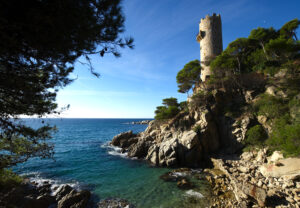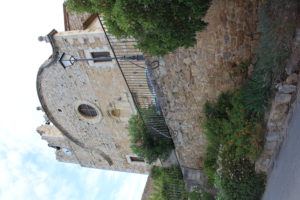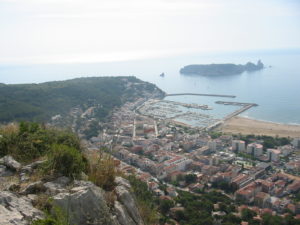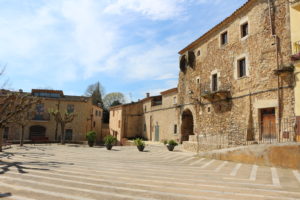Forallac
-
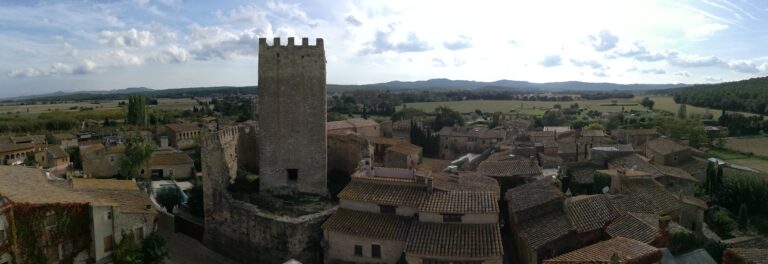
Photo: Ajuntament de Forallac
In the very heart of the Baix Empordà you will find the ancient villages of Vulpellac, Fonteta, Canapost, Peratallada, Sant Climent de Peralta, Santa Susanna de Peralta and Fitor. These places are very close to each other and are jointly known as a single municipality: Forallac.
Forallac includes a broad expanse of plain and the Gavarres mountains, giving it great scenic wealth. As well as its scenic appeal, bounded by fields of crops and mountains, its centres of population have a rich architectural and archaeological heritage.
Vulpellac is the administrative centre of the municipality and is where you will find the council house. The village comprises an old town of great architectural interest that grew around the castle-palace and the late Gothic parish church of Sant Julià and Santa Bassilissa, which features Renaissance details. Walking through the narrow cobbled streets of the village you can see the outline of the fortified centre where traces of the old walls are still visible as well as some defensive towers.
On the last weekend in September, you should not miss the Fira del Conte, or Story Festival. This is a family activity that aims to encourage a taste for reading among children and introduce families to a genre that is of great educational value.
The village of Peratallada, which has been declared a historical-artistic site and cultural asset of national interest (BCIN), is an important site of medieval architecture. The whole village is located on a sandstone rock, which has been worked in various ways, and the village still has its old feudal appearance with great portals, arched windows and authentic ornamental coats of arms on façades, and it is packed with charming corners where you can enjoy losing yourself for a while. While exploring the old part, you can discover different perspectives on the castle–palace, the walls and a complex of popular architecture.
The Fira de les Herbes, or Festival of Herbs, is held on the last Sunday in April and aims to publicise the great variety of herbs that exist and their wide range of uses. Another event not to be missed is the Fira Medieval, or Medieval Fair, which takes place on the first weekend in October. In this fair the town returns to medieval times and the streets are filled with decorations and activities for all visitors.
Midway between Peratallada and Vulpellac is the medieval site of Canapost, which comprises the church of Sant Esteve and a medieval necropolis with important monolithic sandstone sarcophagi. This centre, which consists of a small group of farmhouses located around the parish church of Sant Esteve, is one of the region’s most noteworthy archaeological monuments.
Another of the centres that make up the municipality of Forallac is Fonteta, which is located at the foot of the Gavarres mountains. Some of its streets still have their old cobbles, giving it a characteristic rural aspect of a typical Empordanes village. The village takes its name from the spring, which is next to the church of Santa Maria and still flows. This spring has recently been renovated and there is an inscription on it explaining its relationship to the name of the place (“little spring”).
The village of Fitor is also in the municipality of Forallac. It is located in the heart of the Gavarres and has a very distinctive charm and personality. With holm oak and cork oak woodland and pine groves, it is a welcoming place for walkers, cyclists, hikers and anyone passing through. In Fitor you will find the densest collection of dolmens in the Gavarres area, which is also one of the most important in Catalonia. A significant number of these funerary structures, made from large stone slabs, are still in a good state of preservation and much of their original structure remains visible. The most distinctive element of Fitor is undoubtedly the church of Santa Coloma. This is a Romanesque church that stands majestically over a small plain. The building’s most notable distinctive feature is its large bell tower, which is visible from a large part of the mountain range.
Smaller but no less important are the centres of Sant Climent and Santa Susanna de Peralta. These two neighbouring villages are made up of small monasteries and family homes from the 18th century that dominate a plain of crops typical of the region. You can visit Romanesque churches, the remains of an old monastery and the ruins of a castle in a setting typical of the Empordà, surrounded by woods and crops caressed by the north wind.
In Sant Climent you can still breathe the typical atmosphere of somewhere closely linked to the Gavarres mountains. The old trades are examples of this, such as charcoal burners, who are honoured every October with La Carbonera de Sant Climent (the charcoal burner of Sant Climent). This has become one of the municipality’s most distinctive festive and cultural events. In it the process of making charcoal is recreated and you can experience it in person.
-
Dades de contacte:
Oficina de turisme de Peratallada
Plaça de Castell, 2
17113 Peratallada
T. +34 872 98 70 30
turisme@forallac.cat
https://www.visitperatallada.cat/https://www.facebook.com/visitperatallada/
https://www.instagram.com/ajuntament_forallac/
COMPARTEIX A LES XARXES SOCIALS:





